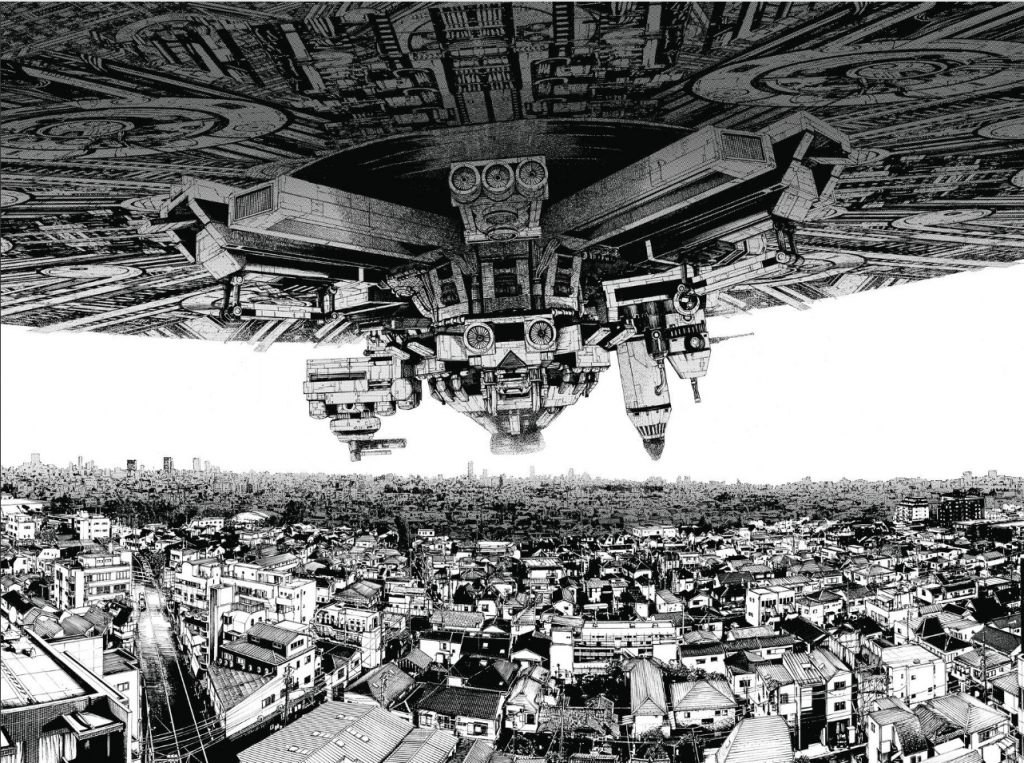
Three years ago, everything changed quite suddenly. An enormous spacecraft appeared above Tokyo, upending daily life, causing widespread panic, throwing the economy into chaos, and leaving the Japanese government and the rest of the world in a panic and scrambling to respond. Three years later, it appears that this was not a true invasion, as it initially seemed to be. Daily life is slowly returning to a semblance of normalcy, while the spaceship continues to sputter and hover over the city.
Inio Asano has been working on Dead Dead Demon’s Dededede Destruction since 2014, but the correlations to this moment feel stark and vivid. Viz Media started releasing it with John Werry’s English translation in April 2018, and Volume 8 of the series is scheduled to be released this summer. As much as this series is about how a seemingly catastrophic event can change the fundamental workings of society, Dead Dead Demon’s Dededede Destruction is also a story about how profound life-changing experiences move alongside the mundanity of life. Asano shines a light on the fact that the small experiences we live through with our families, our friends, our lovers, and our fandoms steer the course of our lives and help us unfold into whom we ultimately come to be, coronavirus or alien “invasion” be damned.

Best friends Kadode Koyama and Oran Nakagawa are at the end of their high school years. An uncertain future awaits them. Sure, there is an alien spacecraft hovering over them daily. Sure, the Japanese Self-Defense Forces are ramping up their response to a seemingly benign wave of alien immigrants. The Japanese government appears to be using this “crisis” to reinvigorate its stagnant economy. The use of “A-Ray” weapons, the presence of crumbled buildings that bear testimony to conflict, and the enormous shadow cast over the city by the spaceship are a daily backdrop to fast and hard changes that few have caught up with. But Kadode and Oran still have to study for college entrance exams, navigate the intricacies of the dynamics between their respective families and their group of friends, try to distinguish between what the government is telling them about their world and the reality of the situation, and, of course, play video games and read their favorite comics.
It is within this juxtaposition of the global and the individual that Dead Dead Demon’s Dededede Destruction finds its heart and it’s Asano’s breathtaking artwork that propels this forward. His ability to convey the scale of things carries so much of the emotional tension in this series. Asano dials into the tightest focus, highlighting something as large as the spaceship hovering over Tokoyo as it dwarfs the building below it, and, at the same time, the various tiny, intricate, and beautiful patterns on the drapes in bedrooms and kitchens. That which looms so largely in the air and the psyche becomes an integrated part of the daily routines of these characters. The large and the small are of equal importance.

This is because Dead Dead Demon’s Dededede Destruction is a human story. While so much of this series could focus on the earth-shaking events at its core, Asano uses his narrative to explore the panoply of amazing characters that make up Kadode and Oran’s world. Sociopolitical commentary runs as an undercurrent throughout the story, and reading this series through the lens of COVID-19 should give the reader pause. Internet conspiracies, global economies in chaos, and images of people wearing masks have taken on new meaning and relevance since Asano began creating Dead Dead Demon’s Dededede Destruction. Throw away moments, like when Kadode’s mother informs her that the food in the fridge isn’t contaminated, are absurd and jaw-dropping in their immediacy. Asano wasn’t speaking to a pandemic in 2014, but it certainly feels that way. And yet, the mess that surrounds these characters isn’t the focus; rather they are in service of the bildungsroman Asano is creating.
While his characters and story are engaging and wonderfully expressed, it is Inio Asano’s art that shines the brightest in this work. His cartooning in Dead Dead Demon’s Dededede Destruction all add up to a vivid display of why his work is so well regarded and why his books are so widely anticipated. His use of perspective to focus the reader’s attention on unusual things normally overlooked and his choice use of negative space backgrounds to highlight emotional beats are amazing. As well, his use of spot grays and crosshatching convey incredible depth and tone. One could spend hours noticing the little details of daily life that pepper his panels, giving the entirety of the series a richness and groundedness.

What makes Dead Dead Demon’s Dededede Destruction such a beautiful work of art is that even in the midst of all that it is and the ways it mirrors some of what we are going through presently, it carries a sweetness and an optimism that is inspiring. In the midst of fear, uncertainty, anxiety, and exhaustion, there is comfort and meaning in the simple day-to-day repetitive acts and the relationships that sustain us. They have as much power to shape and transform us as any global catastrophe.
Special thanks to Alex Hoffman, who contributed to this review.
SOLRAD is made possible by the generous donations of readers like you. Support our Patreon campaign, or make a tax-deductible donation to our publisher, Fieldmouse Press, today.

Leave a Reply